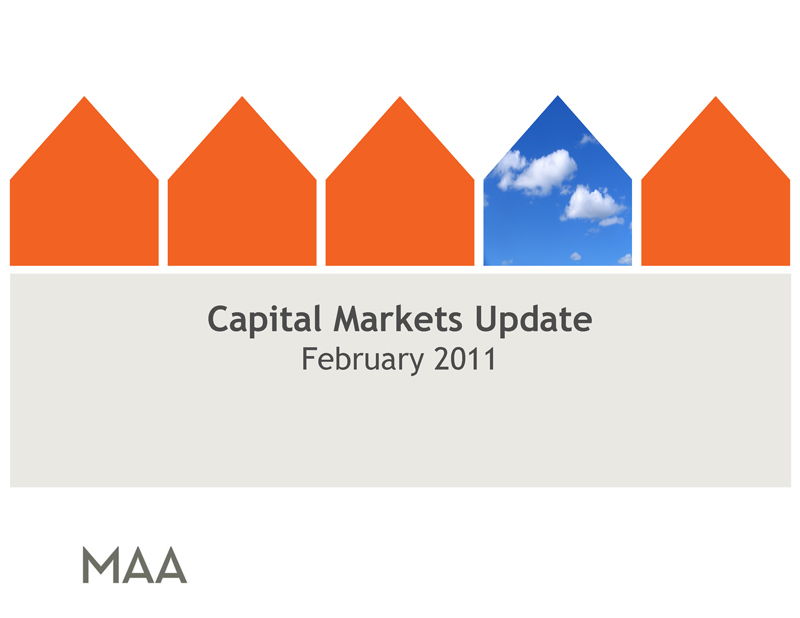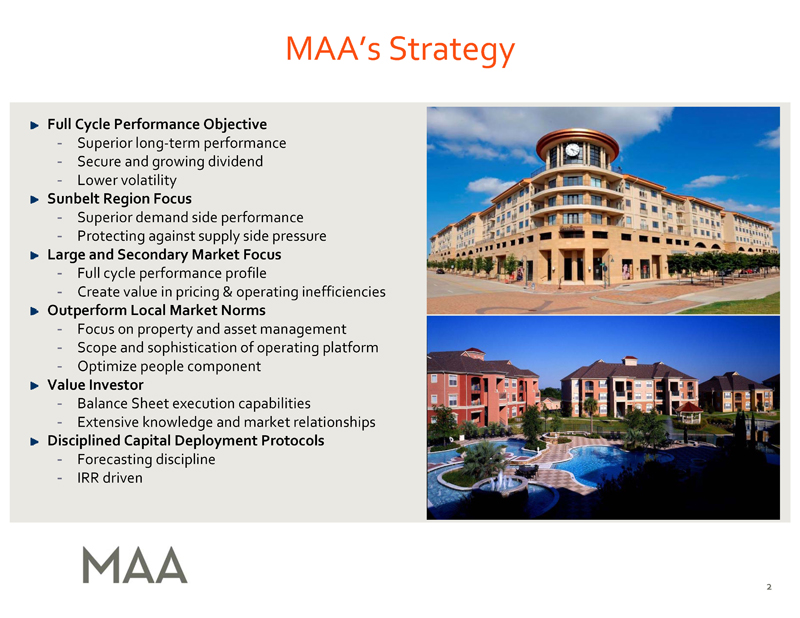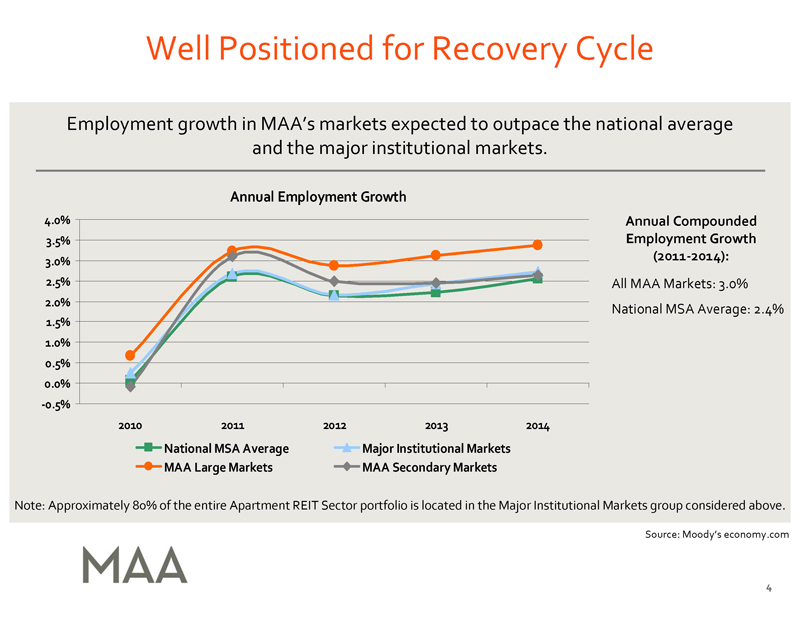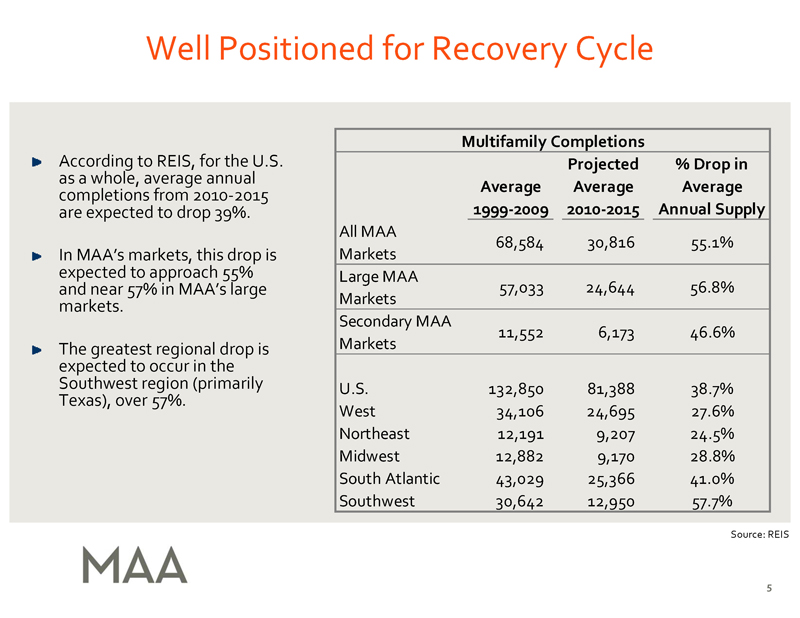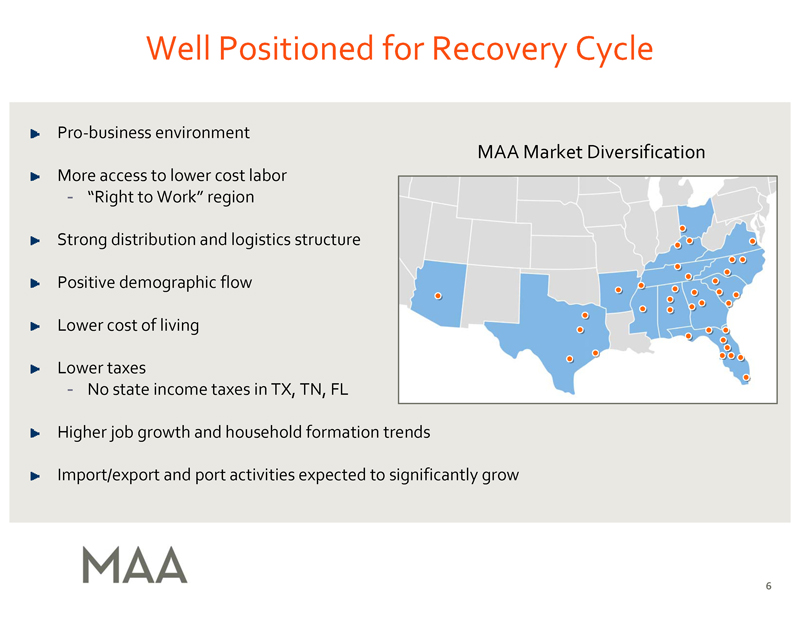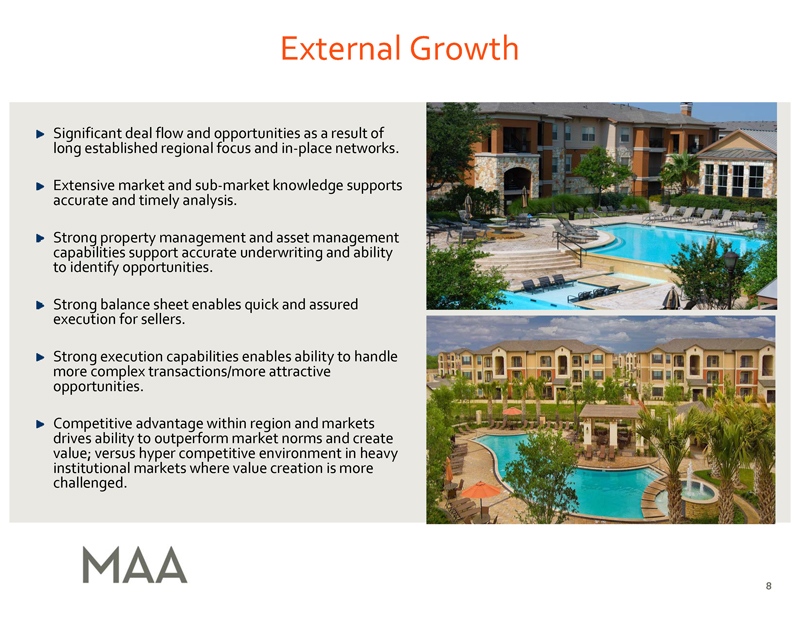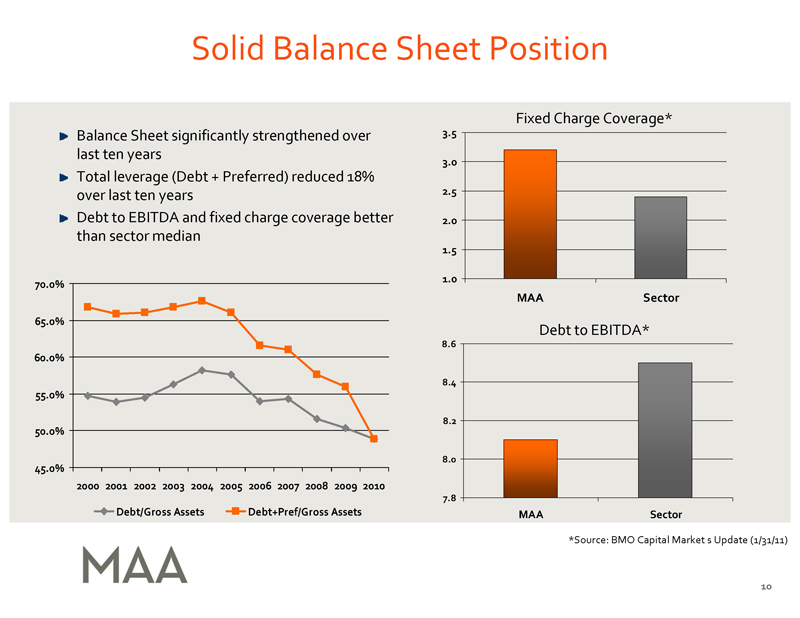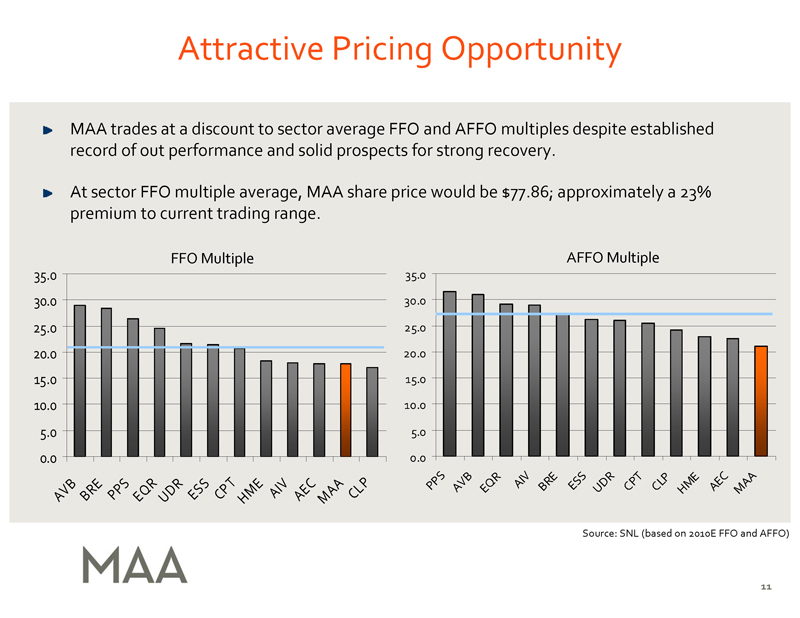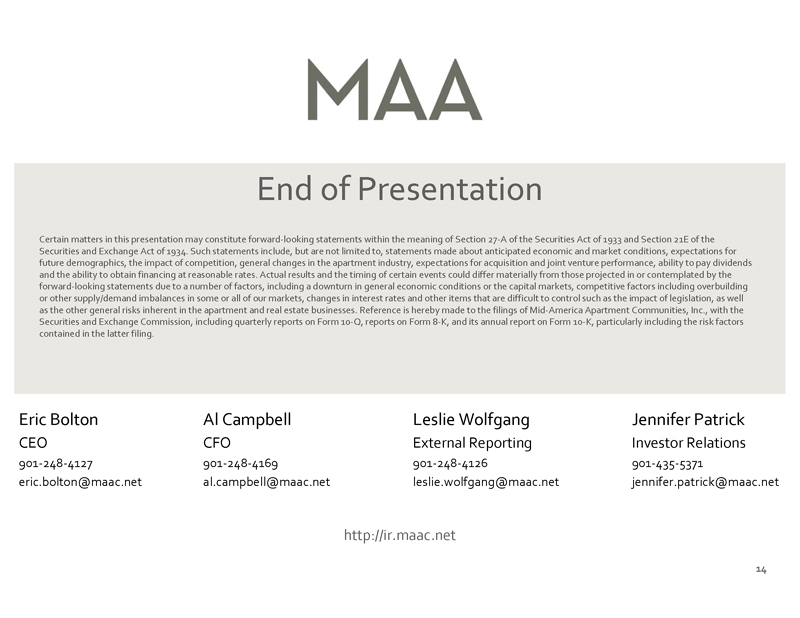Attached files
| file | filename |
|---|---|
| 8-K - MID AMERICA APARTMENT COMMUNITIES INC. | v210355_8-k.htm |
Capital
Markets Update February 2011
MAA’s
Strategy Full Cycle Performance Objective Superior long‐ term performance Secure
and growing dividend Lower volatility Sunbelt Region Focus Superior demand side
performance Protecting against supply side pressure Large and Secondary Market
Focus Full cycle performance profile Create value in pricing & operating
inefficiencies Outperform Local Market Norms Focus on property and asset
management Scope and sophistication of operating platform Optimize people
component Value Investor Balance Sheet execution capabilities Extensive
knowledge and market relationships Disciplined Capital Deployment Protocols
Forecasting discipline IRR driven
Successful
Public Platform MAA total shareholder return has significantly outperformed the
sector Annual compounded return to shareholders over the last 10 years has been
18.1% One of only three multifamily REITs to not reduce dividend over the past
15 years MAA Annual Dividend $2.70 2.0% $2.50 $2.30 $2.10 1.0% $1.90 $1.70 $1.50
0.0% 1 9 F 99 5 07 1 9 97 1 1 1999 20 0 20 0 3 2005 2 0 20 0 2 01 Annual
Compounded Shareholder Return* MAA Sector Avg. 3 Year 17.9% 10.3% 5 Year 10.0%
5.9% 10 Year 18.1% 11.8% 15 Year Compounded Dividend Growth 0.5% Sector * SNL
Financial 1/31/11
Well
Positioned for Recovery Cycle Employment growth in MAA’s markets expected to
outpace the national average and the major institutional markets . Annual
Employment Growth 4.0% Annual Compounded 3.5% Employment Growth (2011‐ 2014):
3.0% 2.5% All MAA Markets: 3.0% 2.0% National MSA Average: 2.4% 1.5% 1.0% 0.5%
0.0% ‐ 0.5% 2010 2011 2012 2013 2014 National MSA Average Major Institutional
Markets MAA Large Markets MAA Secondary Markets Note: Approximately 80% of the
entire Apartment REIT Sector portfolio is located in the Major Institutional
Markets group considered above. Source: Moody’s economy .com
Well
Positioned for Recovery Cycle According to REIS, for the U.S. as a whole,
average annual completions from 2010‐ 2015 are expected to drop 39%. In MAA’s
markets, this drop is expected to approach 55% and near 57% in MAA’s large
markets . The greatest regional drop is expected to occur in the Southwest
region (primarily Texas), over 57%. Multifamily Completions Projected % Drop in
Average Average Average 1999‐ 2009 2010‐ 2015 Annual Supply All MAA 68,584
30,816 55.1% Markets Large MAA 57,033 24,644 56.8% Markets Secondary
MAA 11,552 6,173 46.6% Markets U.S. 132,850 81,388 38.7% West 34,106 24,695
27.6% Northeast 12,191 9,207 24.5% Midwest 12,882 9,170 28.8% South Atlantic
43,029 25,366 41.0% Southwest 30,642 12,950 57.7% Source:
REIS
Well
Positioned for Recovery Cycle Pro‐ business environment MAA Market
Diversification More access to lower cost labor “Right to Work” region Strong
distribution and logistics structure Positive demographic flow Lower cost of
living Lower taxes No state income taxes in TX, TN, FL Higher job growth and
household formation trends Import/export and port activities expected to
significantly grow
External
Growth Cash Flows on New Acquisitions Actual v. Proforma ($000’s) Aggregate
actual cash flows $35,000 $132,000
have exceeded proforma $30,000 $131,000
Outperformed expectations $25,000 131,106
$130,000
despite significant economic $ downturn $20,000 $129,000 $15,000
$128,000 Disciplined protocols for deploying capital $10,000 127,544
$127,000
Creating value through the $5,000 $ $126,000
acquisition process and ongoing management $- $125,000 2003 2004 2005
2006 2007 2008 2009 2010 Total Actual Proforma Note: As an IRR buyer,
total cash flows include NOI, capital expenditures and financing
costs.
External
Growth Significant deal flow and opportunities as a result of long
established regional focus and in‐ place networks . Extensive market and sub‐
market knowledge supports accurate and timely analysis . Strong property
management and asset management capabilities support accurate underwriting
and ability to identify opportunities . Strong balance sheet enables quick
and assured execution for sellers. Strong execution capabilities enables
ability to handle more complex transactions/more
attractive opportunities . Competitive advantage within region and
markets drives ability to outperform market norms and create value;
versus hyper competitive environment in heavy institutional markets where
value creation is more challenged .
Creating
Value through External Growth NOI Operating Margin 60.0% Significant improvement
in operating margins drives value creation 55.0% 2010 MAA able to create value
that less sophisticated operating Operating platforms are unable to achieve Pre
Margin, 50.0% Acquisition 56.0% Operating Capabilities and platform strength
include: Margin, -
Yield management systems and aggressive pricing 45.0% 52.3%
management practices Sophisticated utility management and bill‐ back 40.0%
capabilities Superior inventory management capabilities Disciplined lease
approval and qualifying standards Total Property Value ($000’s) $700,000 - Proactive
collections Highly automated leasing and lease renewal programs Aggregate - Extensive
training and on‐ site skills development $600,000 Value, - Active and “hands
on” management approach $645,676 $500,000 Aggregate Purchase Price,
$400,000 $524,146 Note: Analysis based on all fully stabilized properties
acquired since 2003 (total of 19 properties) . Aggregate current value ($646MM)
determined by using same cap rate at time of purchase against the $300,000
higher NOI achieved by the MAA platform.
Solid
Balance Sheet Position Balance Sheet significantly strengthened over last ten
years Total leverage (Debt + Preferred) reduced 18% over last ten years Debt to
EBITDA and fixed charge coverage better than sector median Sector *Source: BMO
Capital Market s Update (1/31/11) Debt to EBITDA* 70.0% 65.0% 60.0% 55.0% 50.0%
45.0% 2000 2001 2002 2003 2004 2005 2006 2007 2008 2009 2010 Debt/Gross Assets
Debt+Pref/Gross Assets 8.6 8.4 8.2 8.0 7.8 Fixed Charge
Coverage*
Attractive
Pricing Opportunity MAA trades at a discount to sector average FFO and AFFO
multiples despite established record of out performance and solid prospects for
strong recovery . At sector FFO multiple average, MAA share price would be
$77.86; approximately a 23% premium to current trading range. FFO Multiple AFFO
Multiple 35.0 35.0 30.0 30.0 25.0 25.0 20.0 20.0 15.0 15.0 10.0 10.0 5.0 5.0 0.0
0.0 R P S Q AI V SS PPS ESSCP T ACLP P AVB E BRE E U D R CPT C LP HM E AEC MA A
A VBBRE EQRUDR HME AIVA ECMA Source: SNL (based on 2010E FFO and
AFFO)
Attractive
Pricing Opportunity MAA is currently priced at
an implied cap rate discount to the sector average . However, MAA’s historical
long-term internal same store growth (and overall FFO growth) performance
exceeds the sector average; established record of exceeding regional ‘market’
performance levels and sector ‘averages’ . Outlook for continued
‘out-performance’ is positive . Total Implied Unleveraged Return Implied
10 Year IRR: MAA outperforms by 100 bps on unleveraged basis with
continued cap rate discount . MAA outperforms by 170 bps on a
leveraged basis. MAA outperforms by 280 bps on a leveraged basis at the
current peer average cap rate. Source: Cap rate data from BMO Capital
Markets Update (1/31/11) and same store data from Green Street Nov ’10
Residential REIT Update and 12/17/10 2011 U.S. Market Outlook (last full
cycle 2004‐ 2010). 9.0% 8.0% 7.0% 2.3% 6.0% 1.8% 5.0% 4.0% 3.0% 5.7% 5.3% 2.0%
1.0% 0.0% Sector Average MAA Market Implied Cap Rate Same Store
Growth
Summary
Unique strategy with proven long‐ term performance Established and proven
public platform Solid internal growth prospects Competitive strengths enables
regional outperformance Disciplined approach to capital deployment Solid
balance sheet position Well positioned to perform as compared to the sector
Value opportunity as compared to the sector at current
pricing
End of
Presentation Certain matters in this presentation may constitute forward ‐
looking statements within the meaning of Section 27‐ A of the Securities Act of
1933 and Section 21E of the Securities and Exchange Act of 1934. Such statements
include, but are not limited to, statements made about anticipated economic and
market conditions, expectations for future demographics, the impact of
competition, general changes in the apartment industry, expectations for
acquisition and joint venture performance, ability to pay dividends and the
ability to obtain financing at reasonable rates. Actual results and the timing
of certain events could differ materially from those projected in or
contemplated by the forward ‐ looking statements due to a number of factors,
including a downturn in general economic conditions or the capital markets,
competitive factors including overbuilding or other supply/demand imbalances in
some or all of our markets, changes in interest rates and other items that are
difficult to control such as the impact of legislation, as well as the other
general risks inherent in the apartment and real estate businesses . Reference
is hereby made to the filings of Mid‐ America Apartment Communities, Inc., with
the Securities and Exchange Commission, including quarterly reports on Form 10‐
Q, reports on Form 8‐ K, and its annual report on Form 10‐ K, particularly
including the risk factors contained in the latter filing. Eric Bolton Al
Campbell Leslie Wolfgang Jennifer Patrick CEO CFO External Reporting Investor
Relations 901‐ 248‐ 4127 901‐ 248‐ 4169 901‐ 248‐ 4126 901‐ 435‐ 5371
eric.bolton@maac .net al.campbell@maac .net leslie.wolfgang@maac .net jennifer
.patrick@maac .net http://ir .maac.net

